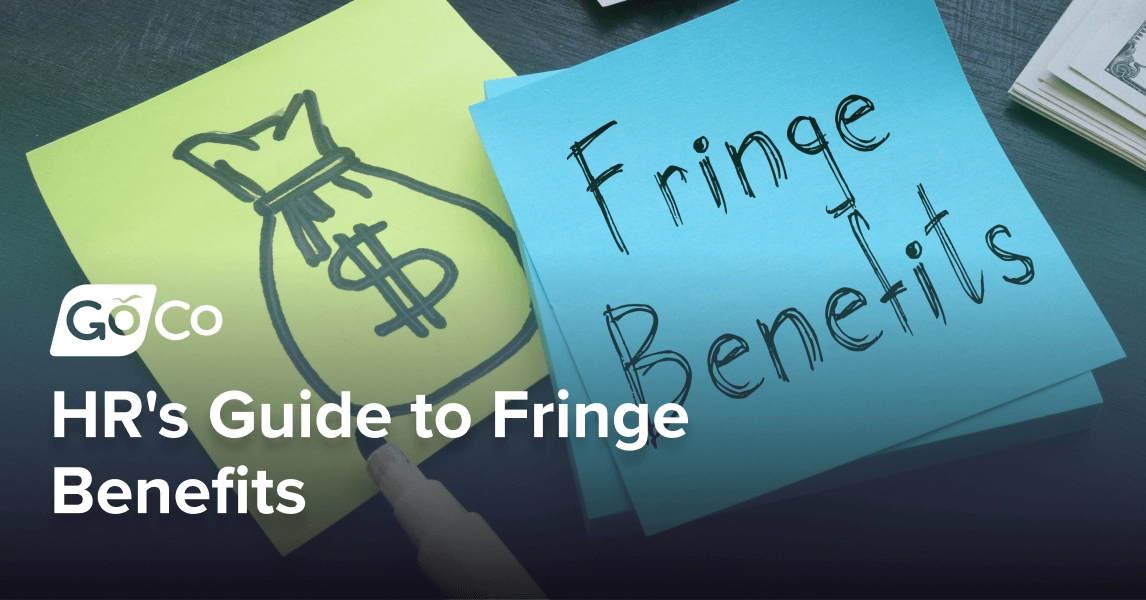HR's Guide to Fringe Benefits
HR employees are tasked with onboarding staff and explaining their fringe benefits to new employees. Learn what you should know about offering these benefits.
October 16th, 2023
A high salary isn't everything. For some job seekers, the promise of employee-only perks is more than enough to seal the deal. After all, some companies offer free gyms and cafeterias, subsidized fertility treatments, and even unlimited sick days.
We are in the wake of the Great Resignation, an event where workers of all industries quit en masse. Companies can't entice new hires with promises of a "competitive salary" and a "fun, engaging work environment" anymore. Employees want good pay, work-life balance, and, in particular, fringe benefits.
What are fringe benefits? Join us as we take a closer look at one of the best tools for attracting and keeping employees.
What Are Fringe Benefits?
The term "fringe" is a bit of a misnomer. It gives the impression that these benefits are under-the-table and unofficial. The sorts of benefits that employees get implicitly, without mention on file or in a contract.
In reality, fringe benefits are just another way of saying "employee benefits." These are perks beyond a regular salary to supplement an employee's monetary compensation. They may apply to all employees or only those above a certain level.
Fringe benefits may exist simply to help employees compensate for their work-related costs. Otherwise, they're a means of building greater job satisfaction. Though these benefits don't come in dollar amounts, they do have taxable value.
Employees can often only begin to receive said benefits after a probationary period. Many places of employment require their new hires to remain for 90 days before those benefits kick in. Also, it's rare for part-time or temporary employees to get benefits whatsoever.
Employees don't always know the full extent of their benefits. This is perhaps where the word "fringe" comes into the equation. More obscure benefits buried in employee documentation may provide unique little advantages as a result of employment.
Examples of Fringe Benefits
Most jobs have at least some form of fringe benefits. In the majority of cases, you are likely to see most jobs including these perks:
Employer-subsidized health insurance
Employer-subsidized 401k retirement plans
Worker's compensation
Paid time off
Family and/or medical leave
Some of these benefits, depending on the type of employment you provide, are mandatory. Things like health insurance, family leave, and worker's compensation. 70% of private sector workers get healthcare from their jobs.
It's virtually impossible to find a job that doesn't have at least a few benefits beyond legal requirements. This has become the paradigm for recruiting employees. Even benefits that have no federal regulation (like paid time off) are common fare at most jobs.
Some companies-particularly startups and tech-sector jobs-provide benefits well above and beyond the norm. This might include things like the following:
Free on-campus facilities
Housing subsidies and stipends
Commute subsidies
Car and life insurance policies
Family-planning aid
Tuition assistance
Reimbursement for childcare
Stock options and employee discounts
In truth, it's really up to the company what sorts of benefits they want to offer. Some, like Google's parent Alphabet Company, go above and beyond with lavish benefit packages to attract top talent.
Why Do Companies Offer Fringe Benefits?
As mentioned before, fringe benefits do have a monetary value at the end of the day. Employees could be receiving hundreds or thousands of dollars of benefits individually. Then there's the tax burden, which we'll handle shortly.
It all amounts to a considerable cost, so it begs the question: why do employers offer them?
Attracting New Talent
Turnover is every company's worst nightmare. It takes a considerable amount of HR resources to onboard a new employee. If they leave in the middle of the process or after training, that's money straight down the drain.
Companies try many different things to improve their employee onboarding process. Things like team-building activities or company events. At the end of the day, though, compensation speaks.
Many of those on the job hunt will flat-out ignore a company based on unsavory benefits alone. This has become the new norm since the pandemic. Promising concrete, genuinely competitive benefits gets more people into the interviewee chair.
Retaining Current Employees
Once an employee remains past the probationary period, HR's work isn't over. Job mobility is very high these days. The phenomenon known as "job hopping" allows employees to get better pay and better benefits through rapid job switches.
Turnover is even more harmful when companies lose long-time employees who know their processes well. It's vital-financially and otherwise-to give people every reason to stay. Fringe benefits are a tool to achieve this.
Many people these days are giving special attention to work-life balance. Gone are the days when employees work free overtime or volunteer for unpaid work.
Leaders must prioritize workplace well-being, and fringe benefits make up part of that equation. Otherwise, employees will walk out the door.
Opening Up Career Advancements
In some cases, benefits may include employee job training and reimbursement for education. These benefits exist to help an employee improve their skills for the employer. For example, an IT professional takes subsidized certification courses to grow their knowledge.
It's a win-win scenario for employers and employees. Employers get more capable, more knowledgeable employees. Employees improve their marketable skills and earning potential.
Pros and Cons of Fringe Benefits
Given that this is ultimately a financial decision, it's important for the HR departments to carefully consider their implementation. Let's examine some pros and cons of offering fringe benefits.
Pros of Fringe Benefits
Naturally, the main advantage of fringe benefits is employee satisfaction. Happy employees are more productive, more obedient, and more loyal. Recruiting employees becomes a lot easier, too.
Dollar-for-dollar, the ultimate cost of fringe benefits may outweigh the loss resulting from unhappy employees. Unsatisfied workers may provide subpar labor. It may be cheaper in the long run to keep on quality existing employees than to hire new ones.
Cons of Fringe Benefits
Benefits packages, even small ones, can be massively expensive. The employees don't see their dollar value, only their benefits. On the accounting department side, you could be shelling out hundreds or thousands for a single employee.
Big companies like Google and Microsoft have begun to strip down their industry-leading, luxurious fringe benefits. If big companies are making such a decision, it stands to reason that fringe benefits may, at times, be prohibitively expensive.
Aside from the required federal benefits, companies often slash voluntary fringe benefits first when cutting costs.
Taxable vs Non-Taxable Fringe Benefits
Are fringe benefits taxable? Oftentimes, yes. Just because you provide a benefit doesn't mean it's tax-free.
Even some of the most lush, costly fringe benefits may add a noticeable increase to your yearly tax season accounting. It's best not to assume a benefit is tax-free because you give it for free.
Taxable Benefits
Fringe benefits are, by default, taxable unless exempted explicitly by the Fed. With the help of your employees, you need to calculate a fair price value in relation to their taxable income. This refers to the market price that the fringe benefit would have on the open market.
Here are examples of taxable benefits:
Gift cards
Prices and awards for company competitions
Personal vacation trips
Club memberships
Financial counseling
Personal company cars
Taxable benefits come in two forms: reimbursement and allowance.
A reimbursement obviously means the employee pays for something with their own money. Then, they submit receipts for compensation. This requires you to predetermine how much money they would need for a particular benefit.
Allowances give them a lump sum for a specific purpose. This can be an amount you disperse over the course of months or years.
Determining If Benefits Are Taxable
Speaking very generally, taxable benefits usually exist for personal use outside of the workplace.
You may even get taxed for having a non-taxable benefit that has unreasonable rates. For example, having a per-mile gas reimbursement that is above market value for a company vehicle.
Non-taxable Benefits
You can ease your tax burden by providing non-taxable fringe benefits. This allows employers to remain competitive in recruiting employees without an onerous tax requirement.
Non-taxable benefits may include the following:
Health and accident benefits
Educational assistance
Employee stock options
Employee discounts
Meals
Employer-provided cell phones
Commuting reimbursement
Retirement fund assistance
As you can see, most of the federally-required benefits are on this list. There are many, many others that are tax-exempt. Even things athletic facilities and adoption assistance, surprisingly, get this distinction.
Determining If Benefits Are Non-Taxable
Keep in mind that these benefits are not necessarily fully tax-exempt. Regulations and rules for fringe benefits govern each one on this list.
Speaking very generally, non-taxable benefits are usually the sort employees avail of at the workplace. Take, for example, employer-sponsored childcare at the office.
Only a few benefits, such as health insurance, are things employees get while off the clock.
Final Thoughts
Fringe benefits refer to non-income perks that employers offer to attract new hires and keep existing employees. While some fringe benefits are mandatory, many employers offer unique perks above and beyond the norm. Fringe benefits tax implications determine how a benefit affects your tax statement.
See the magic of the GoCo HR solution in action by taking a free tour today!
Ready to explore GoCo?
Check out our interactive Product Tour.
Take a Tour →Please fill your info to start experiencing GoCo
Recommended Posts
HR’s Guide to Employee Benefits Administration
Blog Articles
How to Encourage Employees to Use Their Benefits
Blog Articles
10 Creative Ideas To Improve Your Office Environment
Blog Articles
Search...
Product
GoCo
Resources
Articles
eBooks
Webinars
Customer Stories






